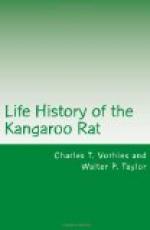The nest cavity is a chamber of approximately spherical shape and from 17 to 23 centimeters in diameter. Chambers of this character were observed and noted as “old storage” in a number of cases. They were sometimes cut off from the rest of the habitation, and at first were supposed to contain abandoned musty storage. As experience in excavating and interpreting results has been gained we have concluded that these chambers in fact represent abandoned nests.
[Illustration: FIG. 3.—Diagram of the system of surface runways and subsidiary dens of Dipodomys spectabilis spectabilis. The underground tunnels of the main den were too complicated to illustrate on this scale, being very similar to those of Figure 2. The underground tunnels of the subsidiaries are shown in solid black. Some runways fade out in the grass in a manner that can not be indicated in a line drawing.]
Bailey gives the dimensions of nest chambers observed in New Mexico as about 6 by 8 inches to 8 by 10 inches. The nest is composed of finer, softer, and more chaffy material than the regular storage. The chaff refuse from the food probably contributes largely to it, though some leaves of grasses not stored for food may also be found, and a nest, especially the one in use, may be distinguished, if excavating is carefully done, by the distinct cavity about the size of a fist in its interior (Pl. IX, Fig. 1). One may sometimes find this cavity distinctly warm from the recent presence of the inhabitant.
The walls or partitions between the chambers and tunnels are in places surprisingly thin, and it is no wonder that one is almost certain to break through in stepping on a mound, since the whole is a honeycomblike structure of from two to four stories in vertical plan, as shown by the transect of a mound in Plate VII, Figure 1. As Bailey writes, these partition walls are a mixture of earth and old food and nest material discarded years ago, resembling the adobe walls of the Mexican houses built of chopped earth and straw. This is the result of the continual ejection of refuse and earth as before mentioned, combined with the caving action of rains and disturbances from larger animals.
Apparently there are no special pockets for deposit of feces in Dipodomys burrows; such matter may be found throughout the den, and is more or less mixed with the food refuse which carpets practically the entire tunnel system. The nest and food stores are, however, clean and neat, the droppings being dry and, though present on the floor of a storage chamber, not actually mingled with the food. Evidently the animal does not clean up the floor litter before storing food material.




